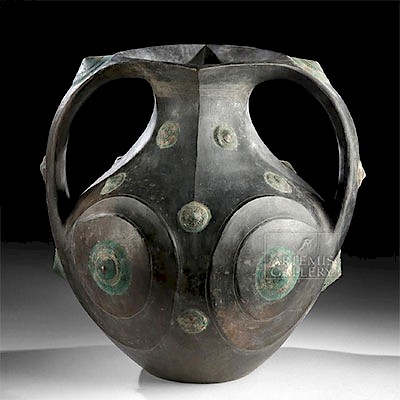Preclassic Maya Stone Transformational Being
Lot 122b
About Seller
Artemis Gallery
686 S Taylor Ave, Ste 106
Louisville, CO 80027
United States
Selling antiquities, ancient and ethnographic art online since 1993, Artemis Gallery specializes in Classical Antiquities (Egyptian, Greek, Roman, Near Eastern), Asian, Pre-Columbian, African / Tribal / Oceanographic art. Our extensive inventory includes pottery, stone, metal, wood, glass and textil...Read more
Estimate:
$6,000 - $9,000
Absentee vs Live bid
Two ways to bid:
- Leave a max absentee bid and the platform will bid on your behalf up to your maximum bid during the live auction.
- Bid live during the auction and your bids will be submitted real-time to the auctioneer.
Bid Increments
| Price | Bid Increment |
|---|---|
| $0 | $25 |
| $300 | $50 |
| $1,000 | $100 |
| $2,000 | $250 |
| $5,000 | $500 |
| $10,000 | $1,000 |
| $20,000 | $2,500 |
| $50,000 | $5,000 |
| $100,000 | $10,000 |
| $200,000 | $20,000 |
About Auction
By Artemis Gallery
Jul 11, 2019
Set Reminder
2019-07-11 10:00:00
2019-07-11 10:00:00
America/New_York
Bidsquare
Bidsquare : Ancient / Ethnographic / Americana
https://www.bidsquare.com/auctions/artemis-gallery/ancient-ethnographic-americana-4246
Discover ancient art from Egypt, Greece, Italy, and the Near East, as well as Asian, Pre-Columbian, Tribal, Fossils and Fine Art. Also featuring a wonderful collection from a prominent New York estate whose owners reside in the Van Wyck family's historic Lloyd Harbor waterfront home. Artemis Gallery info@artemisgallery.com
Discover ancient art from Egypt, Greece, Italy, and the Near East, as well as Asian, Pre-Columbian, Tribal, Fossils and Fine Art. Also featuring a wonderful collection from a prominent New York estate whose owners reside in the Van Wyck family's historic Lloyd Harbor waterfront home. Artemis Gallery info@artemisgallery.com
- Lot Description
Pre-Columbian, Maya territories, late Preclassic, ca. 400 BCE to 250 CE. A fascinating, large, pale sandstone sculpture depicting a shaman in the act of transformation into a sacred jaguar; between his legs he holds a trophy head. The shaman's body is crouched, his limbs contorted as he changes into the pose of a quadruped. His face is still recognizably human, but his wide eyes and mouth make his face a leering rictus, as his tranformation is no doubt painful. The trophy head between his legs is noticeably different in expression, so that there is no mistake that it represents someone dead, with gaping holes for eyes and a slack mouth. The figure is atop and integral to a gently tapering, undecorated base. Size: 13.75" W x 21.5" H (34.9 cm x 54.6 cm); 25" H (63.5 cm) on included custom stand.
A carving of this size must have been made to display in a public space, and was used to reinforce common religious and social themes: shamanic transformation to gain the power of the jaguar, and the taking of trophy heads as part of the ritual of human sacrifice. Indeed, trophy heads were a near-universal constant in Mesoamerican imagery for millennia, although by the Classic Maya period it seems likely that the taking of actual trophy heads had (mostly) been replaced symbolically by the ball from the ballgame (as in the Popol Vuh, where a decapitated head is used instead of a rubber ball). For the Preclassic Maya, however, this was likely a real practice that would have been familiar with the people viewing this statue.
Provenance: private Hawaii, USA collection; ex Harmer Rooke, New York, USA
All items legal to buy/sell under U.S. Statute covering cultural patrimony Code 2600, CHAPTER 14, and are guaranteed to be as described or your money back.
A Certificate of Authenticity will accompany all winning bids.
We ship worldwide and handle all shipping in-house for your convenience.
#132065Excellent deposits on surface. Weathering to form but many details remain clear.Condition
- Shipping Info
-
All shipping is handled in-house for your convenience. Your invoice from Artemis Gallery will include shipping calculation instructions. If in doubt, please inquire BEFORE bidding for estimated shipping costs for individual items.
-
- Buyer's Premium



 EUR
EUR CAD
CAD AUD
AUD GBP
GBP MXN
MXN HKD
HKD CNY
CNY MYR
MYR SEK
SEK SGD
SGD CHF
CHF THB
THB
















